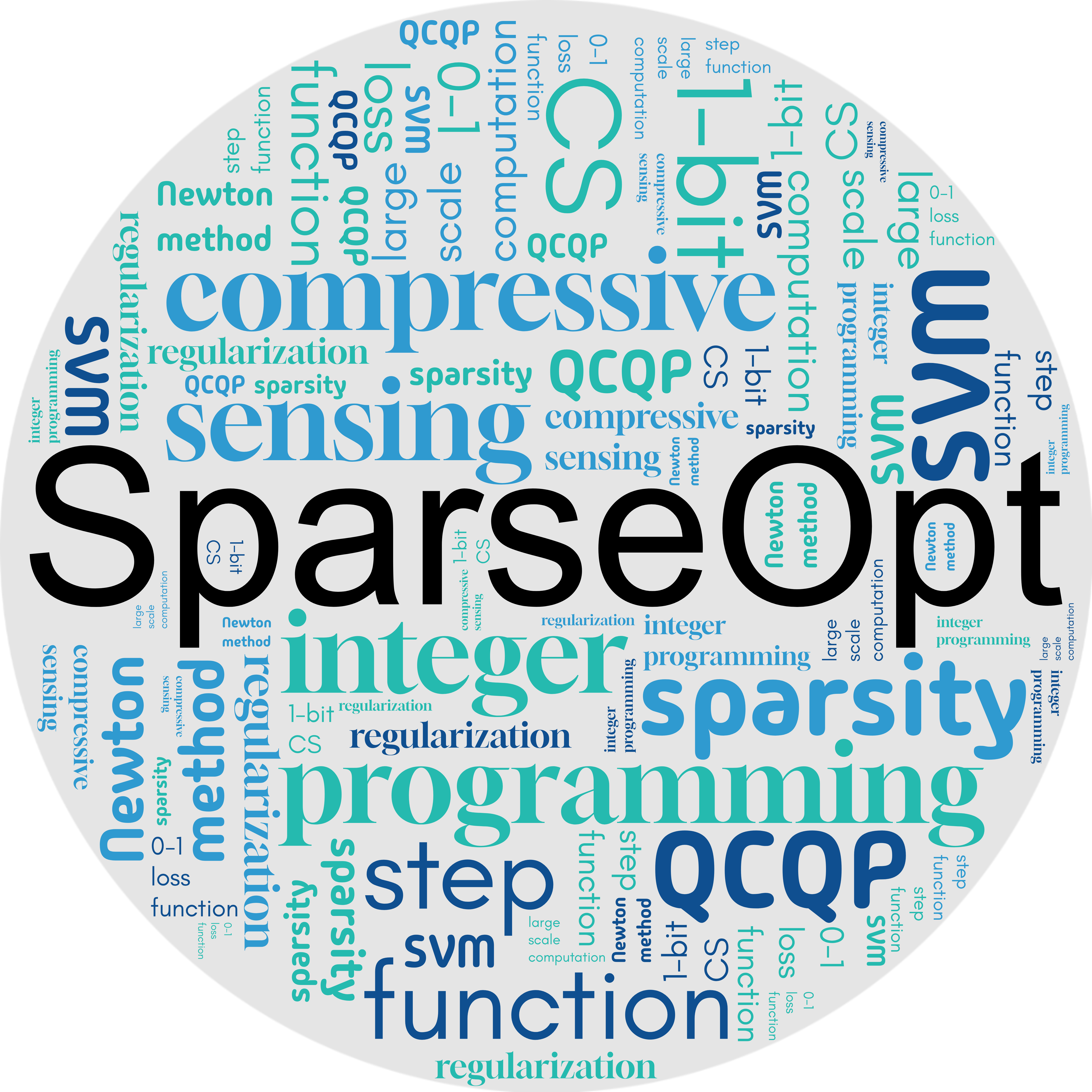1比特压缩感知
1比特压缩感知(One-bit compressive sensing,1BCS)旨在从以下系统中恢复出稀疏信号 $\mathbf{x}\in\mathbb{R}^{n}$,
\begin{equation} \mathbf{b} = \mathrm{Diag}(\mathbf{h}) \mathrm{sign}(\mathbf{A}\mathbf{x} + \boldsymbol{\varepsilon}) \tag{1bCS} \end{equation}
其中,采样矩阵 $\mathbf{A}\in\mathbb{R}^{m\times n}$,观测向量 $\mathbf{b}$ 和符号翻转向量 $\mathbf{h}\in\{-1,1\}^{m}$,噪声 $\boldsymbol{\varepsilon}\in\mathbb{R}^{n}$,对角矩阵 $\mathrm{Diag}(\mathbf{h})$ 的对角元由 $\mathbf{h}$ 组成,符号函数定义为 $\mathrm{sign}(t)=1$ 当 $t>0$,否则 $\mathrm{sign}(t)=-1$。向量情形下,$\mathrm{sign}(\mathbf{x})=$ $(\mathrm{sign}(x_1)$ $\cdots$ $\mathrm{sign}(x_n))^\top$。值得一提的是,观测 $\mathbf{b}$ 是符号翻转后得到的,因而,问题更具挑战性。在该模型中,假设最多有 $k$ 个符号被翻转,即 $\mathbf{h}$ 满足 $\parallel\mathbf{h}-1\parallel_0\leq k$,其中 $k$ 为给定整数,零范数 $\parallel\mathbf{x}\parallel_0$ 表示 $\mathbf{x}$ 中非零元个数。为恢复信号,可求解以下优化模型。
◻️ 双稀疏约束优化模型 \begin{equation} \min_{\mathbf{x}\in\mathbb{R}^{n},\mathbf{z}\in\mathbb{R}^{m}}~ \parallel \mathrm{Diag}(\mathbf{b}) \mathbf{A} \mathbf{x}+\mathbf{z} -\epsilon \parallel^2 + \eta \parallel \mathbf{x} \parallel^2,~~~\textrm{s.t.}~ \parallel\mathbf{x} \parallel_0\leq s,~ \parallel \mathbf{z}_+\parallel_0\leq k \tag{DSCO} \end{equation}◻️ 阶梯函数正则优化模型 \begin{equation} \min_{\mathbf{x}\in\mathbb{R}^{n}}~ \sum_{i=1}^n (x_i^2+\varepsilon)^{q/2}+\lambda \parallel (\epsilon- \mathrm{Diag}(\mathbf{b}) \mathbf{A} \mathbf{x})_+ \parallel_0 \tag{SFRO} \end{equation}
其中, 正整数 $s\ll n$ 和 $k\ll m$, 参数 $(\epsilon,\eta,\varepsilon,\lambda)>0$ 且 $\mathbf{z}_+=$ $(\max\{0,z_1\}$ $\cdots$ $\max\{0,z_m\})^\top$。度量 $\parallel \mathbf{z}_+\parallel_0$ 计算 $\mathbf{z}$ 中正元素的个数,它与阶梯(又称 0/1 损失)函数相关,其定义为 $\mathrm{step}(t)=1$ 当 $t>0$,否则 $\mathrm{step}(t)=0$。因此,$\|\mathbf{z}_+\|_0=$ $\mathrm{step}(z_1)+$ $\cdots$ $+\mathrm{step}(z_m)$。
程序包 - OBCSpack-Matlab 和 OBCSpack-Python(点击下载)提供了 2 个求解器。其核心算法分别来自以下 2 篇文章,其中, $\texttt{GPSP}$ 和 $\texttt{NM01}$ 分别用来求解模型 (DSCO) 和 (SFRO)。
GPSP - S Zhou, Z Luo, N Xiu, and G Li, Computing one-bit compressive sensing via double-sparsity constrained optimization, IEEE TSP, 70:1593-1608, 2022.
NM01 - S Zhou, L Pan, N Xiu, and H Qi, Quadratic convergence of smoothing Newton’s method for 0/1 loss optimization, SIOPT, 31:3184–3211, 2021.
下面 Matlab 代码(Python 代码类似)展示了如何使用 $\texttt{OBCSpack}$ 求解 1BCS 问题。用户需输入数据 ($\texttt{A}$,$\texttt{b}$,$\texttt{s}$,$\texttt{k}$),然后从 {'$\texttt{GPSP}$','$\texttt{NM01}$'} 中选择一个求解器进行求解。
clc; close all; clear; addpath(genpath(pwd));
n = 2000; % Signal dimension
m = ceil(0.5*n); % Number of measurements
s = ceil(0.01*n); % Sparsity level
nf = 0.05; % Noisy ratio
r = 0.02; % Flipping ratio
k = ceil(r*m);
A = randn(m,n);
T = randperm(n,s);
xo = zeros(n,1);
xo(T) = (1+rand(s,1)).*sign(randn(s,1));
xo(T) = xo(T)/norm(xo(T)); % True sparse solution
h = ones(m,1); % Flipping vector
T = randperm(m,k);
h(T) = -h(T);
b = h.*sign(A(:,T)*xo(T)+nf*randn(m,1));;
solver = {'GPSP','NM01'};
out = OBCSpack(A,b,s,k,solver{1});
fprintf(' Time: %6.3f sec\n',out.time);
fprintf(' Absolue error: %6.2f %%\n', norm(xo-out.sol)*100);
fprintf(' Signal-to-noise ratio: %6.2f\n',-10*log10(norm(xo-out.sol)^2));
fprintf(' Hamming distence: %6.3f\n',nnz(sign(A*out.sol)-b)/m)
Matlab 版程序包 $\texttt{OBCSpack}$ 的输入和输出(Python 版的输入和输出类似)如下所示,其中输入 ($\texttt{A}$,$\texttt{b}$,$\texttt{s}$,$\texttt{k}$,$\texttt{solver}$) 为必需项。因为 $\texttt{NM01}$ 求解模型 (SFRO),所以无需参数 $\texttt{s}$ 和 $\texttt{k}$。因此,如果选择 $\texttt{solver}$='$\texttt{NM01}$',则当 $\texttt{s}$ 和 $\texttt{k}$ 未知时,可以将它们设置为 $\texttt{[]}$。参数 $\texttt{pars}$ 是可选的,但设置其中的一些参数可以提升求解器的性能和解的质量。
function out = OBCSpack(A,b,s,k,solver,pars)
% -------------------------------------------------------------------------
% One-bit compressed sensing problem aims to recover a sparse signal x from
%
% b = Diag(h).*sign( A*x + noise )
%
% 1) The double sparsity constrained optimization (DSCO)
%
% min ||Diag(b)*A*x+y-epsilon||^2 + eta||x||^2
% s.t. ||x||_0<=s, ||y_+||_0<=k
%
% where (epsilon, eta)>0, s\in[1,n], k\in[0,m] are given.
%
% 2) The step function regularized optimization (SFRO)
%
% min ||x.*x+vareps||^{q/2}_{q/2} + lam*||(epsilon - Diag(b)*A*x)_+||_0
%
% where (vareps, lam, epsilon)> 0, q\in(0,1).
% -------------------------------------------------------------------------
% Inputs:
% A: The sensing matrix \in R^{m-by-n}, (REQUIRED)
% b: The binary observation \in R^m, b_i\in{-1,1} (REQUIRED)
% s: Sparsity level of x, an integer \in[1,n] (REQUIRED)
% k: An integer in [0,m], e.g., k = ceil(0.01m) (REQUIRED)
% solver: A text string, can be one of {'GPSP','NM01'} (REQUIRED)
% pars: Parameters are optional (OPTIONAL)
% ------------- For GPSP solving (DSCO)--------------------------
% pars.eps - The parameter in the model (default 1e-4)
% pars.eta - The penalty parameter (default 0.01/ln(n))
% pars.acc - Acceleration is used if acc=1 (default 0)
% pars.big - Start with a bigger s if big=1 (default 1)
% pars.maxit - Maximum number of iterations (default 1e3)
% pars.tol - Tolerance of halting condition (default 1e-8)
% ------------- For NM01 solving (SFRO)-------------------------
% pars.x0 - The initial point (default zeros(n,1))
% pars.q - Parameter in the objective (default 0.5)
% pars.vareps - Parameter in the objective (default 0.5)
% pars.epsilon - Parameter in the objective (default 0.15)
% pars.lam - The penalty parameter (default 1)
% pars.tau - A useful parameter (default 1)
% pars.maxit - Maximum number of iterations (default 1e3)
% -------------------------------------------------------------------------
% Outputs:
% out.sol: The sparse solution x
% out.time: CPU time
% out.iter: Number of iterations
% out.obj: Objective function value at out.sol
% ------------------------------------------------------------------------
% Send your comments and suggestions to <<< slzhou2021@163.com >>>
% WARNING: Accuracy may not be guaranteed!!!!!
% ------------------------------------------------------------------------
